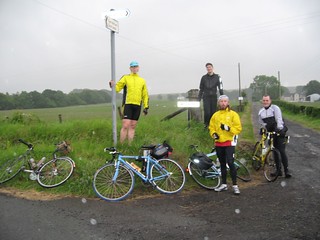You don’t need to grow a pair.
Mar.24, 2013, filed under Cycling
![]() A while back, despite firm resolution not to, I got into an argument on Facebook.
A while back, despite firm resolution not to, I got into an argument on Facebook.
I know.
A fellow cycling enthusiast, one who prefers the Dutch model of segregated facilities (I KNOW) posted about numbers of people cycling. In what I considered to be a counter-productive generalisation, he made an observation that only a small sub-set of risk-taking males choose to cycle on the roads.
Statistically speaking, he might be right, for given values of “statistically speaking”, “sub-set” and “choose”. But it rubbed me up the wrong way, because it’s not a small sub-set of risk-taking males who choose to cycle on the road. I cycle on the road, even when there’s a path available (I find paths inherently more hazardous). I’ve got quite a track record of persuading other women to cycle on the road, too. Frood cycles on the road, and while he’s male (in the strict, biological sense), he’s no risk taker.

I promise these are not risk-taking males. Plus, that’s my Pompino in the middle of the shot.
In fact, the majority of people I know who cycle on the road don’t do so because they’re risk takers, male or female: they do so because their assessment of the risk is much, much less than that of those who insist it’s too dangerous.
People are not going to be encouraged to cycle by the assertion that the only people willing to cycle on the road are risk-taking males. My experience of encouraging others to start cycling suggests that it’s much more effective to explain risk assessment and mitigation in detail. Ride so people can see you; behave in a way that’s predictable (i.e. like traffic); understand that the vast majority of drivers really don’t want to hit you; and pay attention because not everyone else on the road does, but understand that’s mostly because they’re Clarkson-wannabes or desperate to get home because their children are being menaced by a hungry, angry, peedo lion and the house is on fire, which is pretty rare, and here’s how to deal with them.
Of course, that doesn’t support the argument that cyclists absolutely must have fully segregated facilities before even contemplating putting a leg over a top tube. Still, no argument looks all that great when it’s demonstrably false from the get-go.
Cyclists who choose to cycle on the road are not a small sub-set of risk-taking males, although they may include a small sub-set of risk-taking males. They’re mostly people who have looked at the hazards, availed themselves of relevant mitigation strategies (lights, positioning, behaviour, vigilance, route choice) and decided that it’s a relatively safe activity.
Including me.

